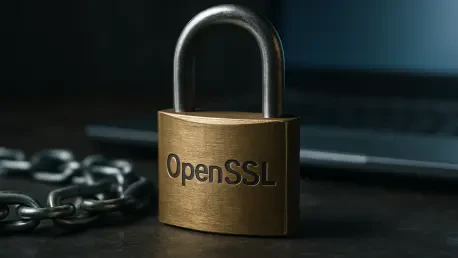I’m thrilled to sit down with Matilda Bailey, a renowned networking specialist whose expertise in cellular, wireless, and next-gen solutions has made her a trusted voice in the cybersecurity community. With a deep understanding of encryption technologies, Matilda is here to shed light on the recent OpenSSL vulnerabilities that have caught the attention of security professionals worldwide. In this interview, we’ll explore the nature of these flaws, their potential impact on systems, and how they fit into the broader landscape of OpenSSL’s security evolution. Let’s dive into the details of these critical patches and what they mean for users and organizations.
Can you give us an overview of the recent OpenSSL vulnerabilities that were patched in the latest updates?
Absolutely, Helen. The OpenSSL Project recently released updates to address three distinct vulnerabilities affecting their SSL/TLS toolkit. These flaws, identified as CVE-2025-9230, CVE-2025-9231, and CVE-2025-9232, were patched across multiple versions, including 3.5.4, 3.4.3, 3.3.5, 3.2.6, 3.0.18, and even older branches like 1.0.2zm and 1.1.1zd. These issues range in severity and impact, from potential private key recovery to denial-of-service conditions, and they highlight the ongoing need to keep systems updated.
How would you describe the severity of these vulnerabilities and what that means for users who rely on OpenSSL?
The severity ratings provide a good starting point for understanding the risks. Two of these vulnerabilities, CVE-2025-9230 and CVE-2025-9231, are classified as ‘moderate severity.’ This rating suggests that while the potential impact could be significant—think code execution or key recovery—the likelihood of exploitation is somewhat constrained by specific conditions. The third, CVE-2025-9232, is rated ‘low severity’ because it primarily leads to a crash causing a denial-of-service, which, while disruptive, doesn’t typically allow attackers to gain deeper access. For users, this means prioritizing updates but not necessarily panicking—context matters, like the specific platforms or configurations in use.
Let’s dive deeper into CVE-2025-9231, the vulnerability tied to private key recovery. What kind of risks does this pose to affected systems?
CVE-2025-9231 is particularly concerning because recovering a private key is a game-changer for an attacker. With that key, they could decrypt sensitive traffic, impersonate legitimate parties, or launch man-in-the-middle attacks, effectively undermining the trust and security of communications. Think of it as someone stealing the master key to your house—everything inside becomes vulnerable. That said, the scope of this issue is limited, which I’ll touch on next, but the potential damage in the wrong hands is still substantial.
Speaking of limitations, can you explain why this private key recovery issue might not affect most users?
Certainly. The vulnerability in CVE-2025-9231 is specific to the SM2 algorithm implementation on 64-bit ARM platforms. That’s a pretty narrow target. On top of that, OpenSSL doesn’t natively support SM2 keys in TLS contexts, meaning most standard deployments aren’t at risk. However, if an organization has integrated custom providers to support such certificates, they could be exposed, especially since the attack could leverage remote timing measurements. So, while the risk is contained, it’s not entirely negligible for certain setups.
Turning to CVE-2025-9230, can you walk us through how this out-of-bounds read/write issue could be exploited and why the risk might be lower than it sounds?
CVE-2025-9230 involves an out-of-bounds read/write flaw, which in theory could let an attacker execute arbitrary code or trigger a denial-of-service attack. Imagine an attacker overwriting memory in a way that lets them run their own malicious instructions or simply crash the system to disrupt services. However, the OpenSSL team has noted that pulling off a successful exploit is tricky. The conditions required to manipulate the flaw into something actionable are complex and not easily replicable in real-world scenarios, which is why they’ve assessed the probability of exploitation as low despite the potential severity.
What can you tell us about the third vulnerability, CVE-2025-9232, and its impact on systems?
CVE-2025-9232 is the least severe of the trio, rated as ‘low severity.’ It can cause a crash leading to a denial-of-service condition, essentially knocking a service offline temporarily. While this isn’t as critical as code execution or key theft, it can still be a headache for systems that need high availability, like web servers or critical infrastructure. The impact largely depends on the environment—systems with redundancy might shrug it off, but smaller setups could face noticeable downtime.
How does OpenSSL’s security track record hold up in recent years, especially when we think back to something as infamous as Heartbleed?
OpenSSL has come a long way since Heartbleed, which was a wake-up call for the entire industry about the risks in widely used open-source libraries. That flaw exposed how a single bug could have catastrophic consequences. In contrast, recent years have shown a marked improvement in OpenSSL’s security posture. The number of serious vulnerabilities has dropped significantly. For instance, in 2025 alone, only three other issues were patched before these, and just one was rated ‘high severity.’ It’s a testament to better auditing and community efforts, though vigilance is still crucial.
Looking at the bigger picture, what’s your forecast for the future of OpenSSL security and the challenges ahead?
I think OpenSSL will continue to strengthen its security through proactive measures like enhanced code reviews and broader adoption of fuzzing and other testing techniques. However, the challenges are evolving. As more devices and platforms integrate OpenSSL—from IoT gadgets to complex cloud environments—the attack surface grows. We’re also seeing more sophisticated adversaries who might target niche implementations, like the SM2 issue we discussed. My forecast is cautiously optimistic: OpenSSL’s community is robust, but staying ahead will require sustained investment in security research and rapid response to emerging threats.









